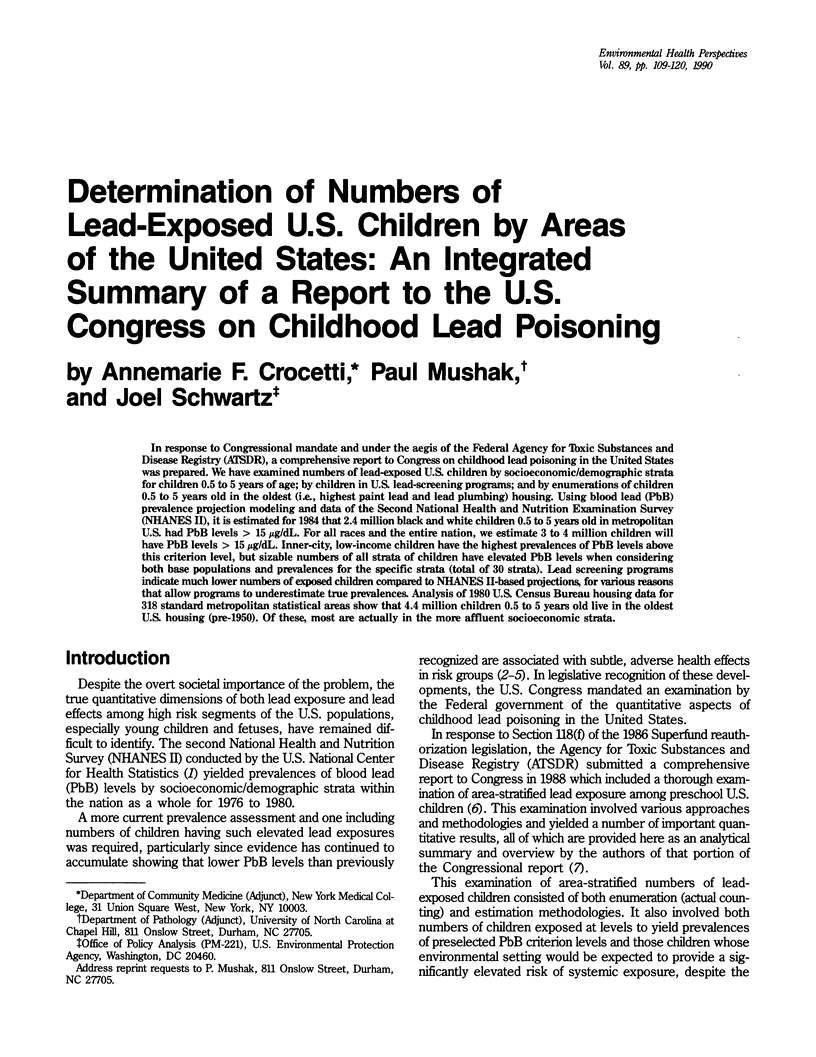Abstract
In response to Congressional mandate and under the aegis of the Federal Agency for Toxic Substances and Disease Registry (ATSDR), a comprehensive report to Congress on childhood lead poisoning in the United States was prepared. We have examined numbers of lead-exposed U.S. children by socioeconomic/demographic strata for children 0.5 to 5 years of age; by children in U.S. lead-screening programs; and by enumerations of children 0.5 to 5 years old in the oldest (i.e., highest paint lead and lead plumbing) housing. Using blood lead (PbB) prevalence projection modeling and data of the Second National Health and Nutrition Examination Surgery (NHANES II), it is estimated for 1984 that 2.4 million black and white children 0.5 to 5 years old in metropolitan U.S. had PbB levels greater than 15 micrograms/dL. For all races and the entire nation, we estimate 3 to 4 million children will have PbB levels greater than 15 micrograms/dL. Inner-city, low-income children have the highest prevalences of PbB levels above this criterion level, but sizable numbers of all strata of children have elevated PbB levels when considering both base populations and prevalences for the specific strata (total of 30 strata). Lead screening programs indicate much lower numbers of exposed children compared to NHANES II-based projections, for various reasons that allow programs to underestimate true prevalences. Analysis of 1980 U.S. Census Bureau housing data for 318 standard metropolitan statistical areas show that 4.4 million children 0.5 to 5 years old live in the oldest U.S. housing (pre-1950). Of these, most are actually in the more affluent socioeconomic strata.
Full text
PDF











Selected References
These references are in PubMed. This may not be the complete list of references from this article.
- Annest J. L., Pirkle J. L., Makuc D., Neese J. W., Bayse D. D., Kovar M. G. Chronological trend in blood lead levels between 1976 and 1980. N Engl J Med. 1983 Jun 9;308(23):1373–1377. doi: 10.1056/NEJM198306093082301. [DOI] [PubMed] [Google Scholar]
- Chisolm J. J., Jr, Mellits E. D., Quaskey S. A. The relationship between the level of lead absorption in children and the age, type, and condition of housing. Environ Res. 1985 Oct;38(1):31–45. doi: 10.1016/0013-9351(85)90070-2. [DOI] [PubMed] [Google Scholar]
- Davis J. M., Svendsgaard D. J. Lead and child development. Nature. 1987 Sep 24;329(6137):297–300. doi: 10.1038/329297a0. [DOI] [PubMed] [Google Scholar]
- Mahaffey K. R., Annest J. L. Association of erythrocyte protoporphyrin with blood lead level and iron status in the second National Health and Nutrition Examination Survey, 1976-1980. Environ Res. 1986 Oct;41(1):327–338. doi: 10.1016/s0013-9351(86)80194-3. [DOI] [PubMed] [Google Scholar]
- Mushak P., Crocetti A. F. Determination of numbers of lead-exposed American children as a function of lead source: integrated summary of a report to the U.S. Congress on childhood lead poisoning. Environ Res. 1989 Dec;50(2):210–229. doi: 10.1016/s0013-9351(89)80002-7. [DOI] [PubMed] [Google Scholar]
- Schneider D. J., Lavenhar M. A. Lead poisoning: more than a medical problem. Am J Public Health. 1986 Mar;76(3):242–244. doi: 10.2105/ajph.76.3.242. [DOI] [PMC free article] [PubMed] [Google Scholar]


